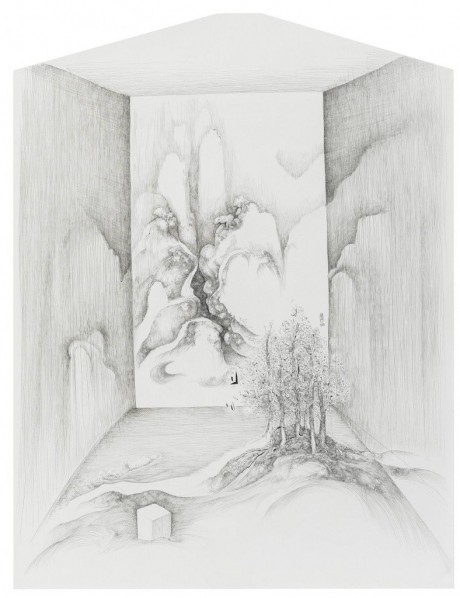
At first glance, the sentimentality of the literati spirit infused in Lin Guocheng’s mystic, surreal landscapes is reminiscent of classical Chinese landscape paintings. Yet a closer look at this otherworldly labyrinth unravels influences ranging from that of Albercht Durer to Liu Dan, a prominent contemporary ink painter who is known for his meticulous depictions of Chinese scholar rocks.
It can be difficult to situate Lin within a particular era, whilst his subject matter and compositions are undeniably Chinese, he paints with an ink pen as opposed to a brush. In that sense, Lin is hardly a traditional ink artist. On one hand, the moisture-laden atmosphere of his landscape, the blurry, misty outline of distant mountains and the textured swirling trees are an homage to the forefathers of classical Chinese landscape painting. On the other hand, the way the way in which he depicts the trees via the dense, repetitive lines bears a clear influence of European sketching. Furthermore, his selective omission of details in certain areas and the meticulousness in others amount to an almost comic-like spontaneity. In essence, Lin’s works are free of the academic orthodoxy, which in turn afford the possibility of these mystical trees and landscapes.

Lin Guocheng,“Open the door and see the mountain II – Await to cross the creek by Feng Chaoran”, Pen and Chinese ink on paper, 150x115cm, 2015
The Chinese way of depicting depth is different from that of the European traditions. There are three different types of compositions: gaoyuan (high distance), pingyuan (low distance) and shenyuan (deep distance), which are respectively: a view across a broad lowland; view from a towering mountain into the afar; and a view past the mountains nearby into the distance. In a way, Lin inherited the way traditional landscape painters conceptualized scenery. Sometimes, between the trees and distant landscape, lies nothing but emptiness.
Lin’s ‘depth’ is not found upon creating a three-dimensional space within that of a two-dimensional one via visual deception, but a different sort of depth. Each of Lin’s works encapsulate a world composed by a labyrinth of lines, through which the viewer identifies objects of familiarity. Yet the trees and the mountains in his works are never fully complete, or even ‘real’, leaving the completion of the landscape to that of our own imaginations.

Lin Guocheng,“Symbiosis”, Pen and Chinese Ink on Paper, 113cm x 128cm, 2015
It seems as though his pensive, desolate scenes are the work of a romantic literati-poet as rather than the works of an ex-computer programmer. Instead of portraying what he sees via rigid forms and composition, he allows the lines to grow spontaneously. His trees seem temporal, forever retaining the possibility of growth. After all, an eternity is composed entirely by temporalities. One can say that Lin is almost painting with time.
It is in the sentimental temporality of his works, where time slips away quietly through the whirling tree branches and the distant misty mountains, that we are reminded of something we have neglected in our daily frenzies. In Lin Guocheng’s melancholic, poetic imagery, one recalls a purer, simpler version of ourselves and the world around us.
About the exhibition
Date: 2015.10.28 Wed - 2015.11.14 Sat
Venue: 3812 London
Courtesy of the artist and 3812 London.




























